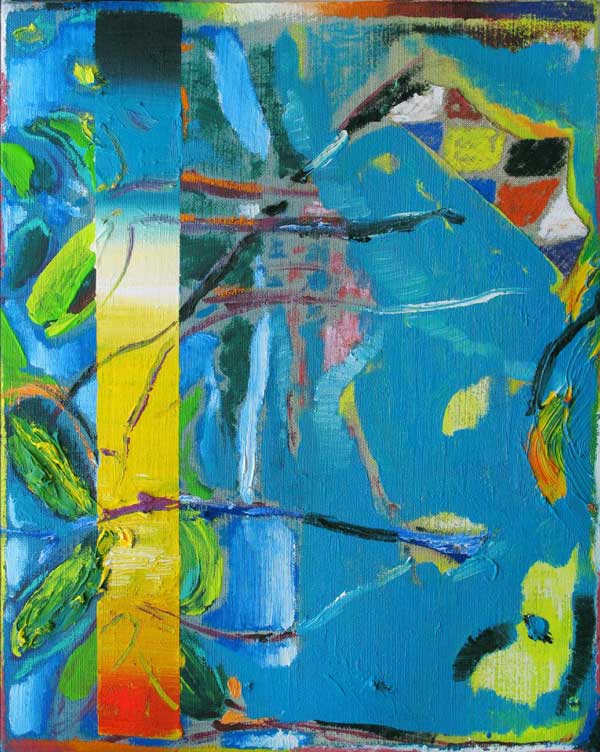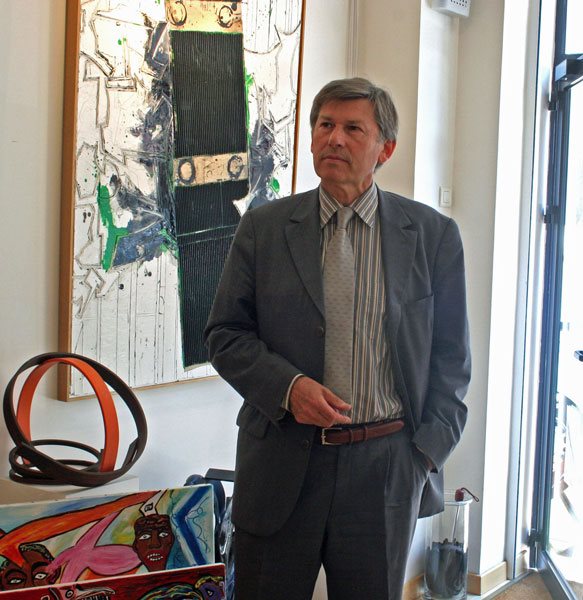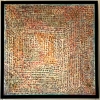LA RECHERCHE DU RAYON VERT SOLO SHOW D'ALLAN VILLAVICENCIO
Commissariat : Anaïs LepageVernissage jeudi 04 avril 18h00 - 21h00 en présence de l'artiste
Opening on Thursday April 4th, 6 - 9 pm the artist will be thereExposition présentée du 05 avril au 25 mai 2019
From April 5th to May 25th 2019
MAËLLE GALERIE
1 - 3 rue Ramponeau 75020 Paris
Métro Belleville - sortie Boulevard de Belleville
http://www.maellegalerie.com/
contact(at)maellegalerie.com
+ 33 (0) 6 14 80 42 00
LA MAËLLE GALERIE EST MEMBRE DU GRAND BELLEVILLE
LA MAËLLE GALERIE EST MEMBRE DU COMITÉ PROFESSIONNEL DES GALERIES D'ART
|
English version below Elaboré selon divers procédés d'excavations et d'agrégations, ce "paysage-fragment" est empreint d'une tension entre un sentiment d'immersion et un caractère éclaté, parcellaire dont la cohérence est rompue par endroit. Autour d'un motif classique de l'histoire de l'art, Villavicencio convoque un récit symbolique de l'occupation de l'espace loin de la supposée neutralité de la perspective. Prolongeant de façon fictive les réflexions d'Hito Steyerl sur l'horizon et la chute1, il réunit deux systèmes de construction de l'espace : la plasticité de la peinture murale et la désorientation des espaces virtuels. Il en emprunte un refus d'horizon unifié, une fantasmagorie souvent délirante, une sensation de déséquilibre associée à une stimulation sensorielle décuplée et accélérée — ainsi qu'une dimension politique de la composition. Partout, Allan Villavicencio sème ainsi des réminiscences mentales d'images et de gestes. Nous pourrions entrevoir, ici et là, des échos aux sculptures massives et entrelacées du mural autrefois effacé de David Alfaro Siqueiros America Tropical (1932), ou encore les accents cubistes du Paisaje Zapatista (1915) de Diego Rivera dans l'organisation des pleins et des vides. Ces échos visuels agissent comme des "calques" venant se superposer les uns aux autres autant disjoints que liées entre eux. Les souvenirs des mouvements du corps dans de multiples directions invitent aussi à relire L'Oeil et l'Esprit (1964), dernier écrit de Maurice Merleau-Ponty en bord de mer, sous un autre jour : ''Il faut retrouver le corps opérant et actuel, celui qui n'est pas un morceau d'espace, un faisceau de fonctions, qui est un entrelacs de vision et de mouvement''2. Il est ici un visible éprouvé par le corps en train de peindre mais aussi par le regardeur en train de contempler à peinture. Tout est affaire de focale sensible, du "corps voyant-visible". À nous de nous demander ce que nous avons sous les yeux et quels en sont les modes d'existences. Pour continuer avec les mots du philosophe, ces éléments, "lumière, éclairage, ombres, reflets, couleur, tous ces objets de la recherche ne sont pas tout à fait des êtres réels : ils n'ont, comme les fantômes, d'existence que visuelle"3. "La Recherche du rayon vert" se déploie ainsi dans une combinatoire de couleurs et de formes qui tient du camouflage, du trompe-l'oeil autant que du mirage, à l'image de l'observation du phénomène atmosphérique dont elle décrit l'attente. Dans une réflexion sur l'en cours et le fini, il en serait de l'acte pictural comme de la quête du Rayon Vert : celle d'un prétexte à la recherche du visible et de la désorientation, de l'éclatement, un temps, des perspectives. Un détour contre la ligne. 1 Hito Steyerl, In Free Fall : A Thought Experiment on Vertical Perspective, eflux journal, 2011. A green ray, or flash, is an atmospheric phenomenon, an illusion produced by a variance in the perception of the horizon and the earth's curve. At dawn or dusk – and only when the weather is fine – a green ray forms above the upper rim of the solar disk as it rises or sets. Its causes – be they scientific, poetic or literary – and the rarity of its appearance make it a metaphor for the horizon as promise, continuation and construction. In this exhibition, Allan Villavicencio assembles a new series of works, in a configuration especially designed for the gallery space and in affinity with this optical manifestation. Here, he continues his experimentation with painting as perception: visual perception, sensible or material perception, and physical perception. For him, painting is an accumulation of matter and sensations. His practice oscillates between a formal relation to a pictorial object, and a gestural and intuitive process that includes the traces and hazards of chance. Taking inspiration from the spatial experimentation characteristic of Mexican muralism, from the sensations of navigation in 3D virtual landscapes, and from the energy of the urban environment, this exhibition is conceived of as a total landscape. It brings together three corpuses: a mural painting, encaustic paintings, and what Allan Villavicencio calls volume "projections" of paintings. The constant shifts between these different ensembles – between the narrative figuration of a deconstructed tropicality and the distance of abstract motifs – encourage layered readings and the ambiguity of relations. The mural section sketches a space in motion in which the notion of centre is evacuated, as is the possibility of omnisciently embracing the ensemble. The encaustic paintings, for their part, return to an ancient technique to depict fragments of visions. The volume projections constitute an array of ersatz and residues of the landscape in the space. Devised through different procedures of excavation and aggregation, this "landscape-fragment" is infused with a tension between a sentiment of immersion and a fractured, piecemeal character whose coherence is broken in places. Based on a classical motif of art history, Villavicencio convokes a symbolic narrative of the occupation of space far from the so-called neutrality of perspective. Fictitiously prolonging Hito Steyerl's reflections on the horizon and falling1, he brings together two systems of spatial construction: the plasticity of mural painting and the disorientation of virtual spaces. He draws on its refusal of a unified horizon, an often hallucinatory phantasmagory, a sensation of imbalance associated with a heightened and sped-up sensorial stimulation – and a political dimension of the composition. Throughout, Allan Villavicencio thereby sows mental reminiscences of images and gestures. Here and there we can see echoes of the hitherto erased massive and interlaced sculptures of David Alfaro Siqueiros' mural, America Tropical (1932), or the Cubist accents of Diego Rivera's Paisaje Zapatista (1915) in its organization of hollows and protrusions. These visual echoes act like "layer masks" superimposed on one another, both disjointed and connected together. The memories of the body's movements in multiple directions invites a re-reading of Maurice Merleau-Ponty's final work, L'Oeil et l'Esprit (Eye and Mind, 1964), written by the sea, in another light: "we must go back to the working, actual body—not the body as a chunk of space or a bundle of functions but that body which is an intertwining of vision and movement"2. Here we have a visibility experienced by the body as it paints, but also by the viewer contemplating the painting. It is all a matter of sensible focal distance, of the "seeing-seeable body". It is up to us to ask ourselves what we have before our eyes and what its modes of existence are. Continuing in the words of the philosopher, these elements, "Light, lighting, shadows, reflections, color, all these objects of his quest are not altogether real objects; like ghosts, they have only visual existence"3. "In search of the green ray" thus unfolds in a combinatorial of colours and forms akin to camouflage, trompe-l'œil, and to mirage, in the image of the observation of the atmospheric phenomenon whose awaiting it describes. In a reflection on the in-progress and the completed, it may be perceived as its pictorial act and the quest for the Green Ray: that of a pretext to go searching for the visible and for disorientation, fragmentation, a time, perspectives. A deflection against the line. 1 Hito Steyerl, In Free Fall : A Thought Experiment on Vertical Perspective, eflux journal, 2011. |

















